12 Best Low Code Development Platforms of 2025: A Deep Dive

The pressure to build and deploy applications faster has never been greater. Traditional coding, while powerful, can be a bottleneck, slowing down innovation and time-to-market. This is the core problem solved by the best low code development platforms: they empower developers and business users to build sophisticated applications with minimal hand-coding, dramatically accelerating the entire development lifecycle.
But navigating the crowded market of low-code tools is a challenge. With every platform claiming to be the best, how do you find the one that truly fits your project's unique needs, especially if you're a developer working on specialized applications? This guide cuts through the marketing fluff to provide a practical, in-depth analysis of the top 12 platforms available today.
We go beyond generic feature lists, offering honest assessments of each tool's strengths, limitations, and ideal use cases. You'll find direct links and screenshots for every platform reviewed. We'll explore established enterprise solutions alongside innovative newcomers like Dreamspace, a unique vibe coding studio and AI app generator designed to accelerate development for crypto and blockchain projects. Our goal is simple: to give you the clear, direct insights needed to select the right tool and start building immediately.
1. Dreamspace
Best For: No-Code Blockchain and Onchain Application Development
Dreamspace stands out as one of the best low-code development platforms by targeting a highly specialized yet rapidly growing niche: decentralized applications. It fundamentally redefines onchain development, transforming it from a complex, code-intensive process into an intuitive and creative experience. Branded as a "vibe coding" studio, Dreamspace empowers users without traditional programming skills to build, audit, and deploy sophisticated crypto applications.
At its core, the platform uses an AI-powered, drag-and-drop canvas. This interface allows creators to generate and launch smart contracts compatible with any EVM blockchain, a task that typically requires deep technical expertise. This unique approach makes Dreamspace a powerful AI app generator for the Web3 space, lowering the barrier to entry for innovators, artists, and entrepreneurs.
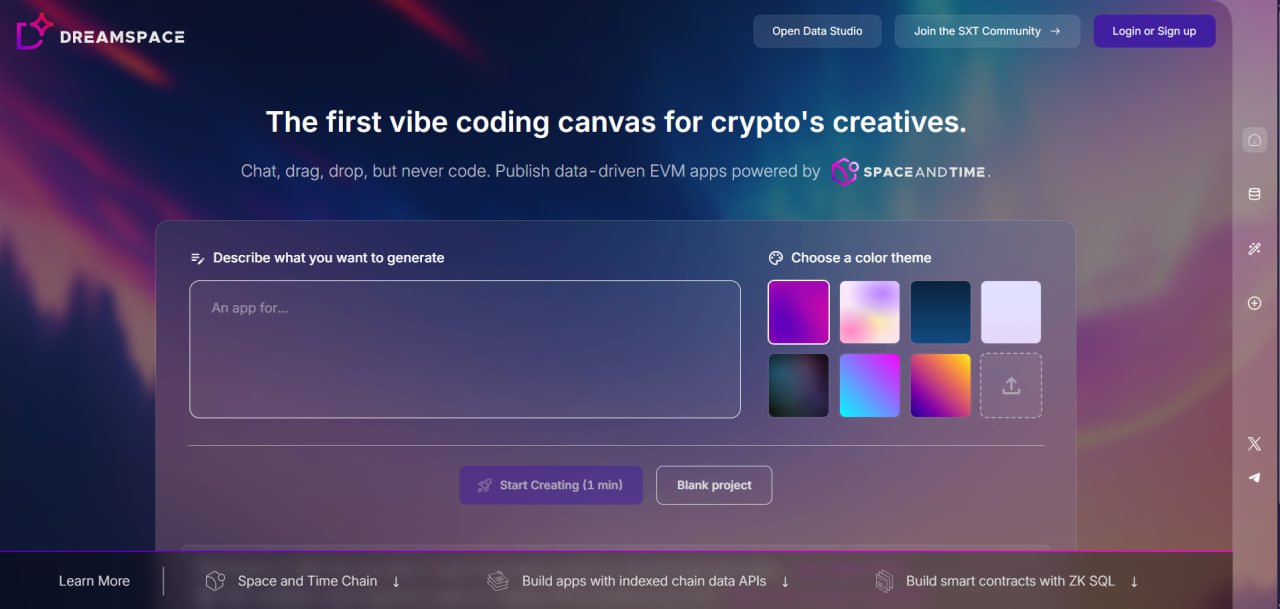
Key Strengths and Use Cases
One of its most compelling features is the prompt-to-SQL capability. Users can leverage indexed blockchain data to build dynamic charts and data visualizations simply by describing what they want to see. This is invaluable for creating analytics dashboards, NFT project trackers, or DeFi protocol monitoring tools without writing a single line of code.
Practical applications include launching a new NFT collection, creating a decentralized voting application, or building a custom crypto portfolio tracker. The platform streamlines the entire workflow, from smart contract creation to front-end website deployment, allowing for rapid prototyping and go-to-market strategies.
Website: https://dreamspace.xyz
2. Mendix
Mendix positions itself as a high-performance, all-in-one low-code platform designed for building enterprise-grade applications at scale. It distinguishes itself by supporting the entire development lifecycle, from ideation and building to deployment and iteration, all within a unified visual environment. Its AI-assisted development, known as Mendix Assist, provides real-time guidance and quality checks, which helps both new and experienced developers build more robust applications faster.
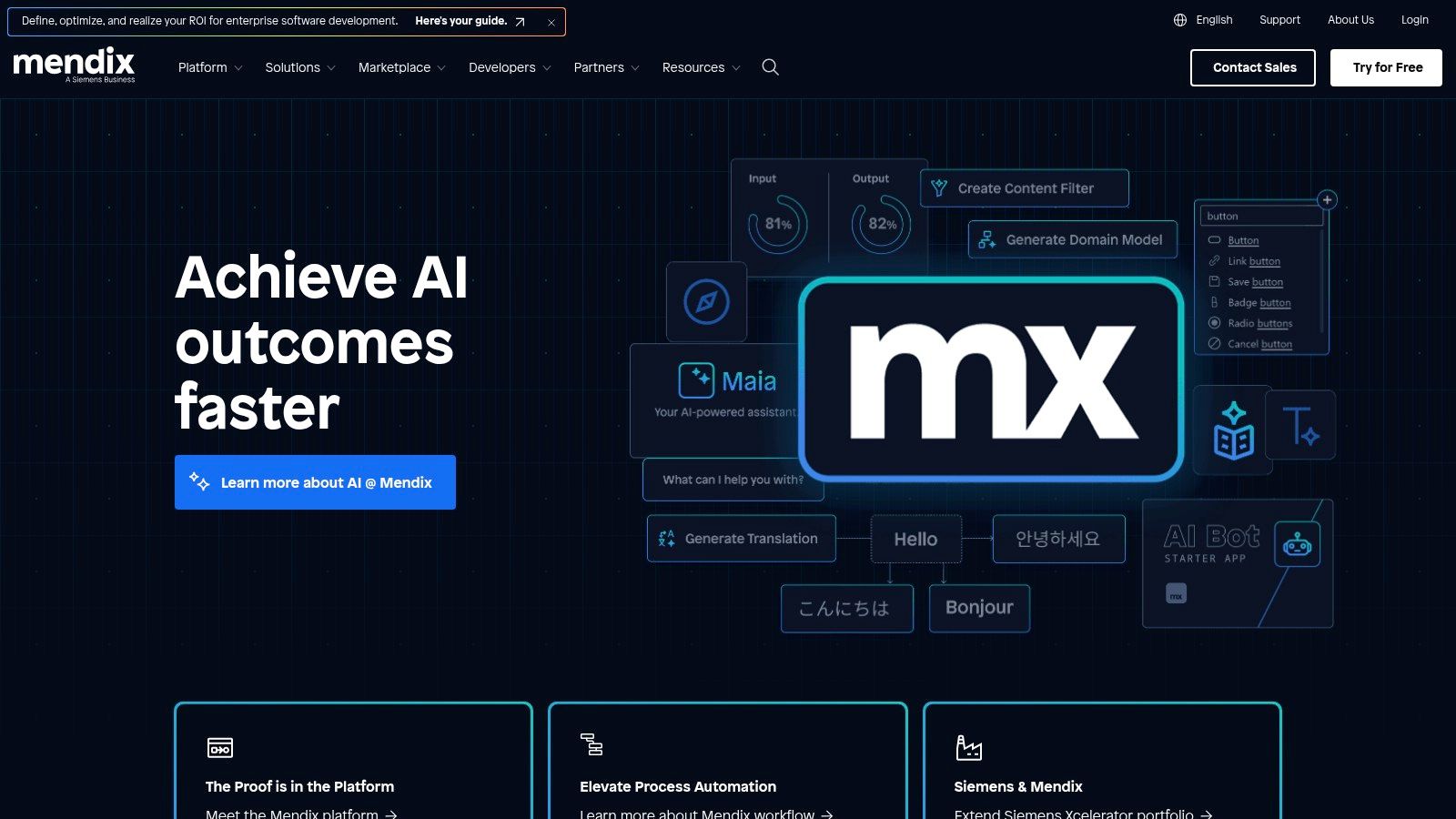
Unlike simpler tools, Mendix offers a dual-IDE approach. Mendix Studio provides a purely visual, no-code environment for business users, while Mendix Studio Pro offers more powerful low-code capabilities for professional developers, allowing for complex logic and custom code extensions. This flexibility makes it one of the best low-code development platforms for collaborative projects involving both technical and non-technical stakeholders.
Key Considerations
- Best Use Case: Developing complex, scalable enterprise applications, especially those requiring deep integration with existing systems like SAP and extensive governance controls.
- Pricing: Mendix offers a free tier for small-scale applications. Paid plans are enterprise-focused and priced based on the number of users and application scope, which can be a significant investment.
- Limitations: The platform's extensive feature set contributes to a steeper learning curve compared to more basic builders. The pricing model can also be prohibitive for small businesses or individual developers. For those seeking a more intuitive, AI-native experience, an AI app generator like Dreamspace might offer a faster path to building a functional MVP.
Website: https://www.mendix.com
3. OutSystems
OutSystems is a high-performance low-code platform focused on serious application development for the enterprise. It provides full-stack visual development capabilities, allowing teams to build, deploy, and manage critical applications with exceptional speed. A key differentiator is its emphasis on integrating with complex legacy systems and providing advanced security and governance features right out of the box, making it a reliable choice for mission-critical operations.
The platform empowers developers to visually design everything from UIs to complex business logic and data models. Its integrated performance monitoring tools allow for real-time analysis and optimization, ensuring applications remain scalable and robust under heavy load. This holistic approach makes OutSystems one of the best low-code development platforms for organizations looking to modernize their application portfolio without sacrificing control or performance.
Key Considerations
- Best Use Case: Building and deploying complex, scalable, and secure enterprise-level web and mobile applications that require strong integration and lifecycle management.
- Pricing: OutSystems offers a free edition for individual use or small teams. Paid plans are enterprise-centric and tailored to organizational needs, representing a significant investment for larger deployments.
- Limitations: The platform's powerful feature set can present a steeper learning curve, and achieving advanced customization often requires developer expertise. The cost structure can also be a barrier for smaller businesses. For those seeking a more streamlined, AI-driven development process, an AI app generator like Dreamspace could offer a faster, more intuitive path to application creation.
Website: https://www.outsystems.com
4. Appian
Appian excels by merging low-code application development with powerful process automation. It is designed for businesses that need to build sophisticated applications to streamline and automate complex operational workflows. The platform uses a highly visual interface to map out business processes, manage cases, and integrate AI services, making it a strong contender for organizations focused on digital process transformation and operational efficiency.
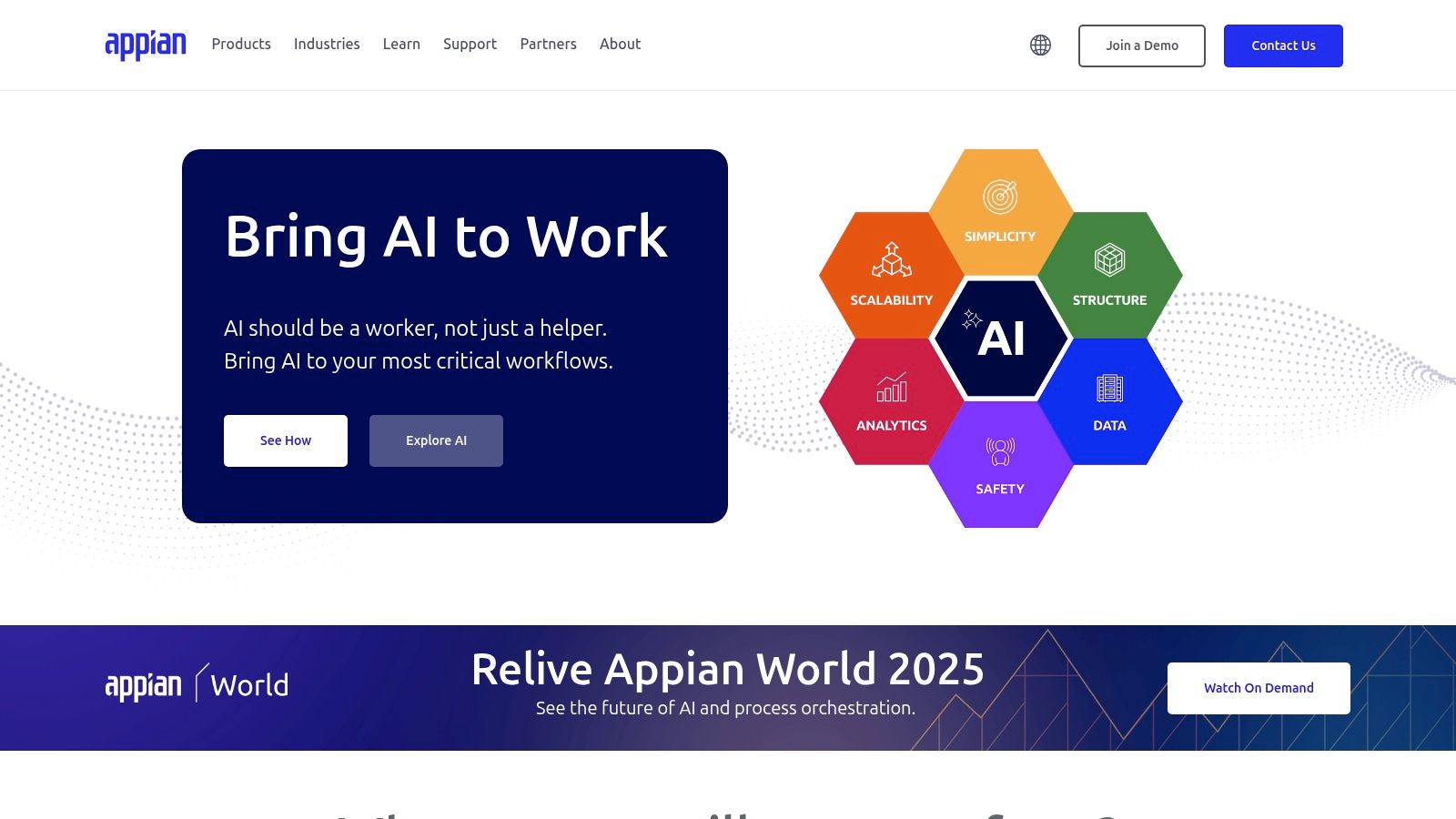
What sets Appian apart is its deep focus on process-centric applications. While many platforms can build data-driven apps, Appian's core strength lies in orchestrating human tasks, robotic process automation (RPA), and AI within a single, unified workflow. This makes it one of the best low-code development platforms for industries like finance, insurance, and government, where compliance and intricate process management are paramount.
Key Considerations
- Best Use Case: Automating and managing complex, multi-step business processes and case management systems that require integration with multiple enterprise data sources.
- Pricing: Appian offers a free tier for learning and small applications. Enterprise pricing is quote-based and tailored to specific needs, which may create uncertainty for budget planning.
- Limitations: The platform's extensive capabilities, particularly in process modeling, can introduce a steeper learning curve than simpler app builders. For teams prioritizing rapid, AI-native development without deep process automation, an AI app generator like Dreamspace could provide a more direct path to launching an initial product.
Website: https://www.appian.com
5. Microsoft Power Apps
Microsoft Power Apps is a dominant force in the low-code space, primarily due to its deep and seamless integration with the broader Microsoft ecosystem. It empowers business users and citizen developers to quickly build and deploy custom applications that connect to their existing data in services like Office 365, Dynamics 365, and Azure. The platform's core strength lies in its simplicity and accessibility, allowing non-technical users to digitize processes and solve business problems with minimal coding.
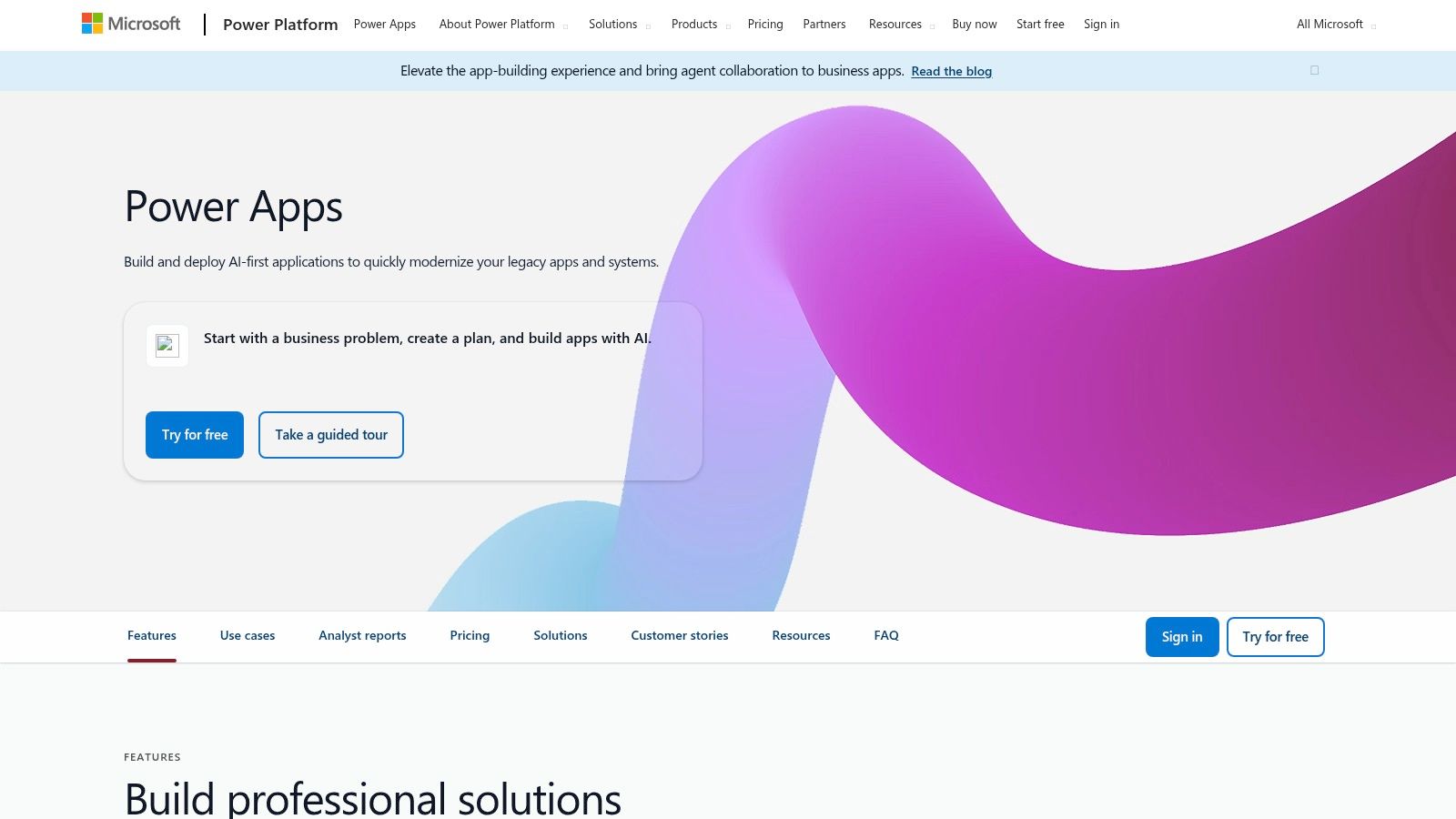
Its extensive library of connectors and pre-built templates for common use cases like inspections or budget tracking significantly accelerate development. The inclusion of AI Builder allows users to easily add intelligence to their apps, such as form processing or object detection, without needing data science expertise. This makes it one of the best low-code development platforms for organizations already invested in Microsoft's technology stack looking to enhance productivity and automate workflows.
Key Considerations
- Best Use Case: Rapidly creating internal business applications, automating departmental workflows, and mobilizing data for teams heavily reliant on Microsoft products.
- Pricing: Power Apps is often bundled with Microsoft 365 and Dynamics 365 plans, making it highly cost-effective for existing customers. Per-app and per-user plans are also available, starting at a competitive price point.
- Limitations: The platform is heavily centered on the Microsoft ecosystem, and integrations outside this environment can be less straightforward. Advanced customization and UI design can feel restrictive compared to more flexible platforms. For projects demanding greater creative freedom or an AI-native development approach, a vibe coding studio like Dreamspace could provide a more versatile solution.
Website: https://powerapps.microsoft.com
6. Zoho Creator
Zoho Creator carves out its niche as a highly accessible and affordable low-code platform, making it a strong contender for small to medium-sized businesses. Its core strength lies in its tight integration within the extensive Zoho ecosystem, allowing users to build custom applications that seamlessly connect with CRM, Books, and other business tools. This creates a unified environment where data flows freely, automating workflows and eliminating information silos without extensive coding knowledge.
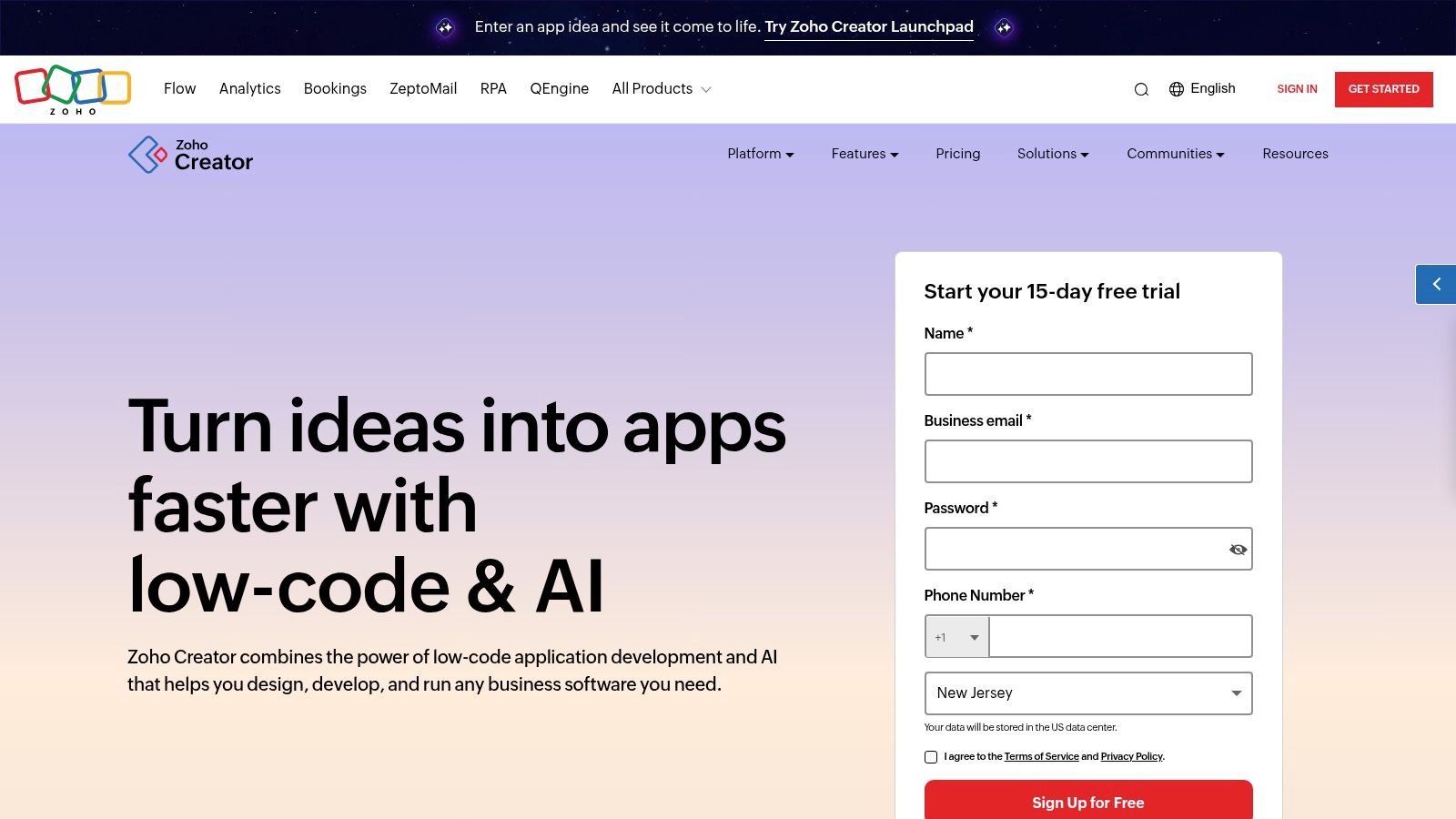
The platform emphasizes simplicity with a clean drag-and-drop interface, pre-built templates, and a powerful mobile app builder. This user-friendly approach empowers business users and citizen developers to digitize internal processes, from inventory management to custom approval systems, with minimal technical assistance. While it excels at straightforward business applications, it is one of the best low-code development platforms for organizations already invested in Zoho's suite of products.
Key Considerations
- Best Use Case: Building custom internal tools, mobile forms, and business process automation for SMBs, especially those already using other Zoho applications.
- Pricing: Zoho Creator offers a free plan and highly competitive paid tiers, starting from just a few dollars per user per month, making it one of the most cost-effective solutions on the market.
- Limitations: Its power is most realized within its own ecosystem, and it may lack the advanced scalability and complex logic capabilities of enterprise-focused platforms. Users needing more complex, standalone AI-powered applications may find an AI app generator like Dreamspace better suited for rapid, intelligent app creation.
Website: https://www.zoho.com/creator
7. Salesforce Lightning
Salesforce Lightning is a component-based, low-code application development framework built to extend the functionality of the Salesforce ecosystem. It excels at creating custom applications that are deeply integrated with your CRM data, allowing businesses to tailor workflows, automate processes, and enhance customer relationship management with personalized user experiences. Its primary strength lies in its ability to leverage existing Salesforce infrastructure, making it a natural choice for companies already invested in the platform.
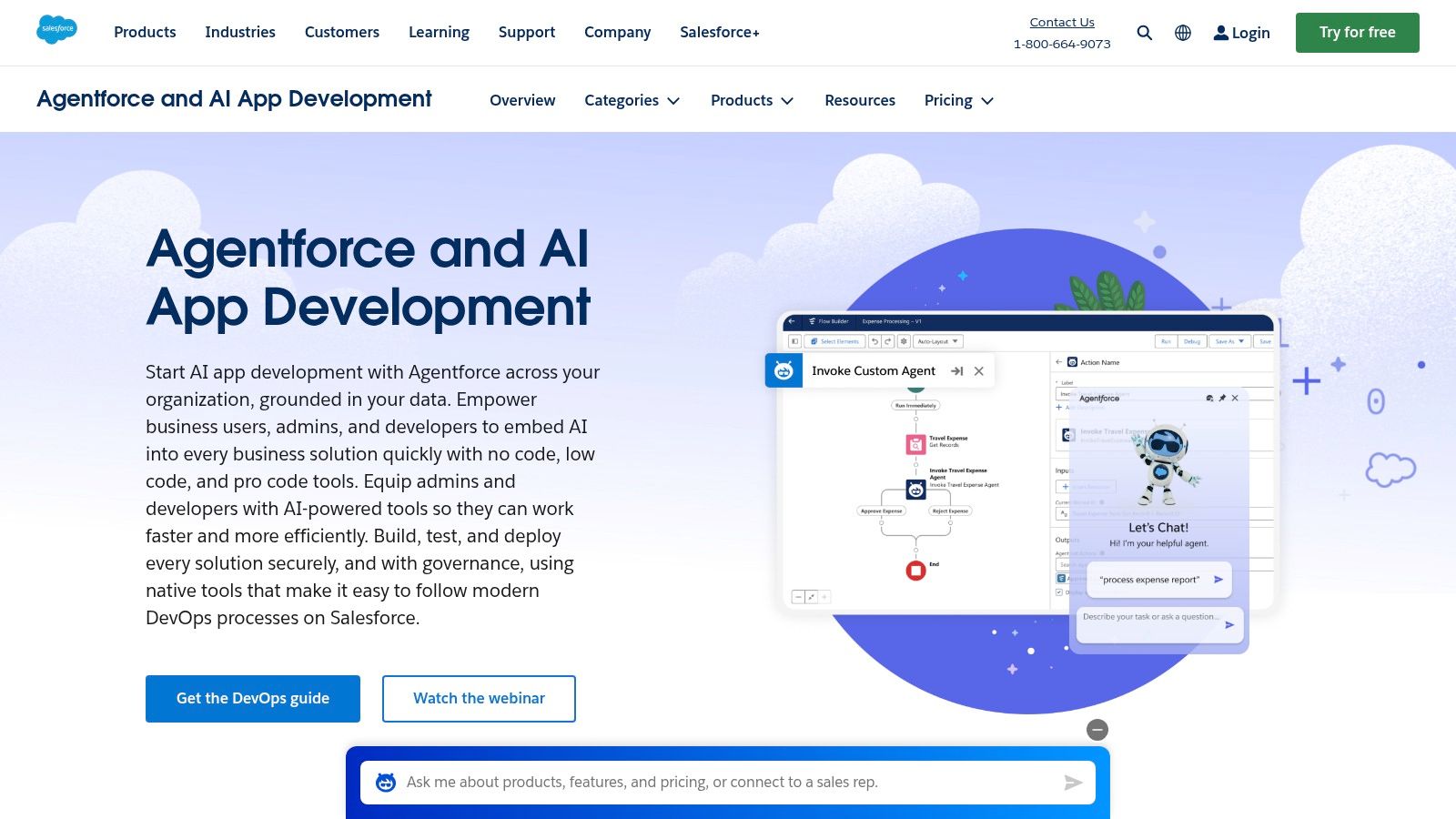
The platform utilizes a drag-and-drop interface and a rich library of pre-built components, enabling users to assemble responsive, mobile-ready applications with minimal coding. This makes it one of the best low-code development platforms for creating powerful internal tools and customer-facing portals that directly interact with CRM data. The focus is less on building standalone products from scratch and more on augmenting the core Salesforce functionality to meet specific business needs.
Key Considerations
- Best Use Case: Businesses looking to build custom applications, automated workflows, and dashboards that are tightly integrated with their existing Salesforce CRM data.
- Pricing: Access to the Lightning Platform is included with various Salesforce licenses, but pricing can be complex and prohibitive for organizations not already using Salesforce.
- Limitations: The platform's greatest strength is also its main limitation: it operates almost exclusively within the Salesforce ecosystem. This dependency makes it unsuitable for general-purpose application development. For creating standalone web applications without this constraint, an AI app generator like Dreamspace provides more flexibility and a faster, AI-driven development cycle.
Website: https://www.salesforce.com/products/platform/lightning
8. Kissflow
Kissflow is a unified low-code and no-code work platform designed to empower business users and citizen developers. It focuses on simplifying the automation of internal business processes, from simple approvals to complex operational workflows, using an intuitive visual development environment. The platform's core strength lies in its accessibility, allowing non-technical teams to design, build, and deploy applications without writing a single line of code, thereby democratizing app development across an organization.

Unlike developer-centric platforms, Kissflow prioritizes business process management (BPM) and workflow automation. It provides users with pre-built templates and a straightforward drag-and-drop interface to model processes, create forms, and set up approval chains. This focus makes it one of the best low-code development platforms for departments like HR, finance, and operations looking to quickly digitize their internal procedures and eliminate manual tasks.
Key Considerations
- Best Use Case: Automating internal business processes, managing workflows, and enabling citizen development within non-IT departments for tasks like employee onboarding, purchase requests, and issue tracking.
- Pricing: Kissflow offers several tiers, starting with a Basic plan for small teams. Pricing scales based on the number of users and the feature set required, with dedicated plans for enterprise needs.
- Limitations: While excellent for process automation, its customization capabilities are limited for developers seeking to build highly complex or unique applications. Users may find it less flexible than platforms with more robust low-code features. For those focused on creating custom external applications with AI capabilities, an AI app generator like Dreamspace may offer more creative freedom.
Website: https://kissflow.com
9. Unqork
Unqork carves out a unique space in the market as a purely no-code platform specifically engineered for complex, enterprise-level applications. It enables large organizations, particularly in regulated industries like finance and insurance, to build sophisticated software entirely through a visual interface. This "codeless" philosophy means developers and business users alike work with reusable components and drag-and-drop logic, eliminating the need to write or manage a single line of code.
The platform’s strength lies in its ability to handle intricate workflows and stringent security requirements without sacrificing development speed. Features like auto-documentation for APIs and data models streamline governance and maintenance, a critical factor for enterprise IT. This focus on high-stakes, code-free development makes Unqork one of the best low-code development platforms for organizations looking to digitize core operations securely and at scale.
Key Considerations
- Best Use Case: Building mission-critical, data-intensive applications for regulated industries such as financial services, insurance, and healthcare where compliance and security are paramount.
- Pricing: Pricing is entirely enterprise-focused and available only upon request. This model is tailored to large-scale deployments and can be a barrier for smaller companies.
- Limitations: The platform's powerful, enterprise-grade feature set introduces a significant learning curve, especially for mastering complex workflow logic. The opaque pricing model also lacks transparency. For teams prioritizing rapid prototyping with more creative freedom, a vibe coding studio like Dreamspace could provide a more direct and intuitive development experience.
Website: https://www.unqork.com
10. Betty Blocks
Betty Blocks champions the citizen developer movement, offering a cloud-native, no-code platform that empowers business users to build sophisticated applications without writing a single line of code. Its strength lies in its purely visual modeling environment, which abstracts away technical complexity and promotes genuine collaboration between IT departments and business stakeholders. This focus on accessibility allows organizations to rapidly develop and deploy web, mobile, and back-end applications, bridging the gap between business needs and technical execution.
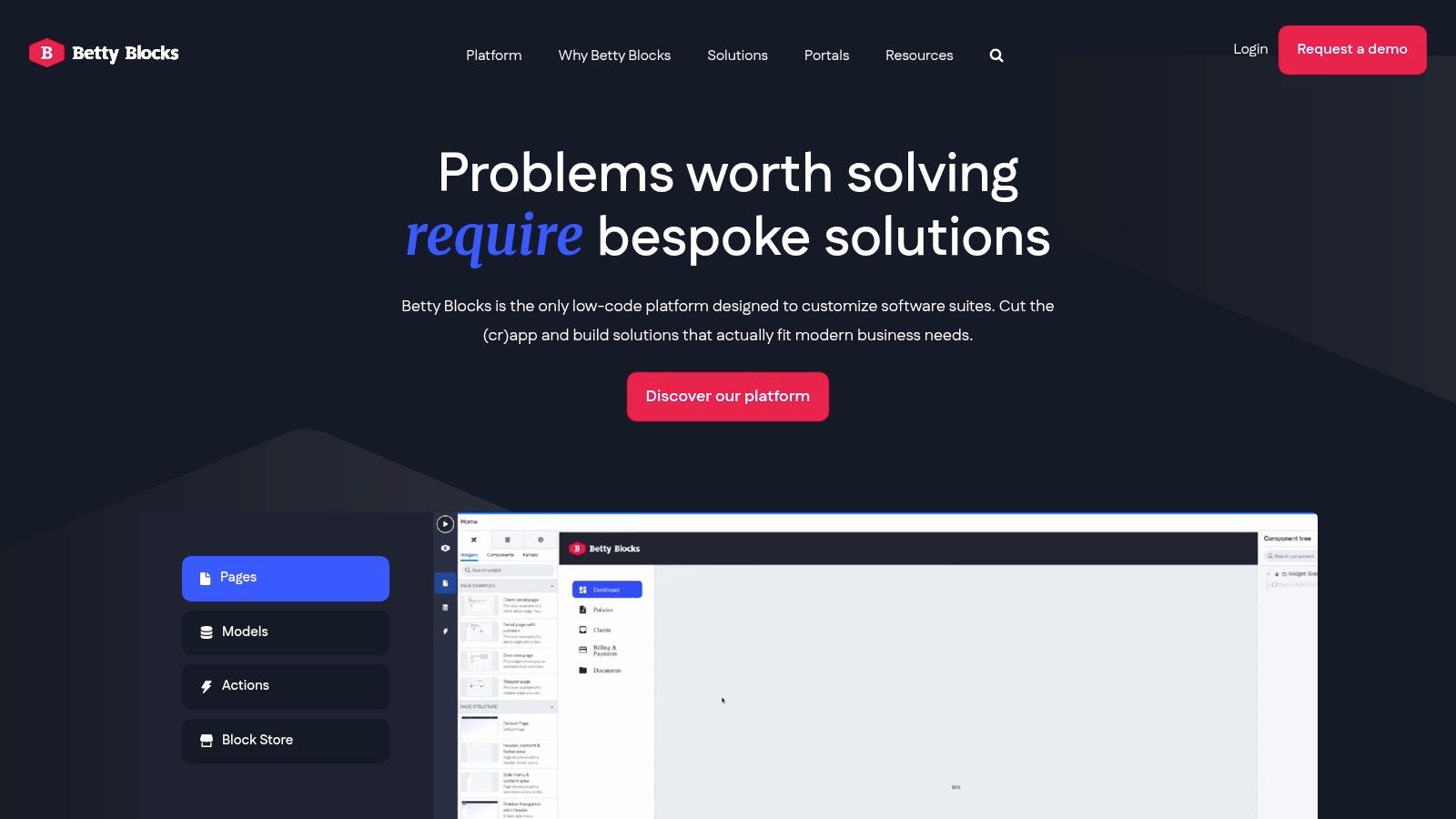
Unlike platforms that require some coding for customization, Betty Blocks is designed to be fully no-code, although it allows for escape hatches where needed. It offers a rich library of pre-built integrations and reusable components, accelerating the development process significantly. This approach makes it one of the best low-code development platforms for organizations aiming to foster innovation across departments and reduce their reliance on strained IT resources.
Key Considerations
- Best Use Case: Empowering non-technical "citizen developers" to build internal tools, departmental applications, and customer portals, thereby fostering business-led innovation.
- Pricing: Pricing is customized and available only upon request. This model is typical for enterprise-focused solutions but can lack transparency for smaller teams evaluating options.
- Limitations: The platform's commitment to no-code can limit its ability to handle highly complex business logic or performance-intensive operations. While it is powerful, for those wanting a platform that uses AI to translate ideas into applications from the ground up, an AI app generator like Dreamspace provides a more direct path from concept to code.
Website: https://www.bettyblocks.com
11. DronaHQ
DronaHQ is a low-code platform specializing in the rapid development of internal tools and custom business applications. It empowers organizations to build operational apps, admin panels, and data dashboards quickly, boosting internal efficiency without extensive coding. The platform stands out by offering a highly intuitive visual builder combined with pre-built UI controls and configurable workflows, which makes it accessible for both business users and developers to create multi-experience outputs.
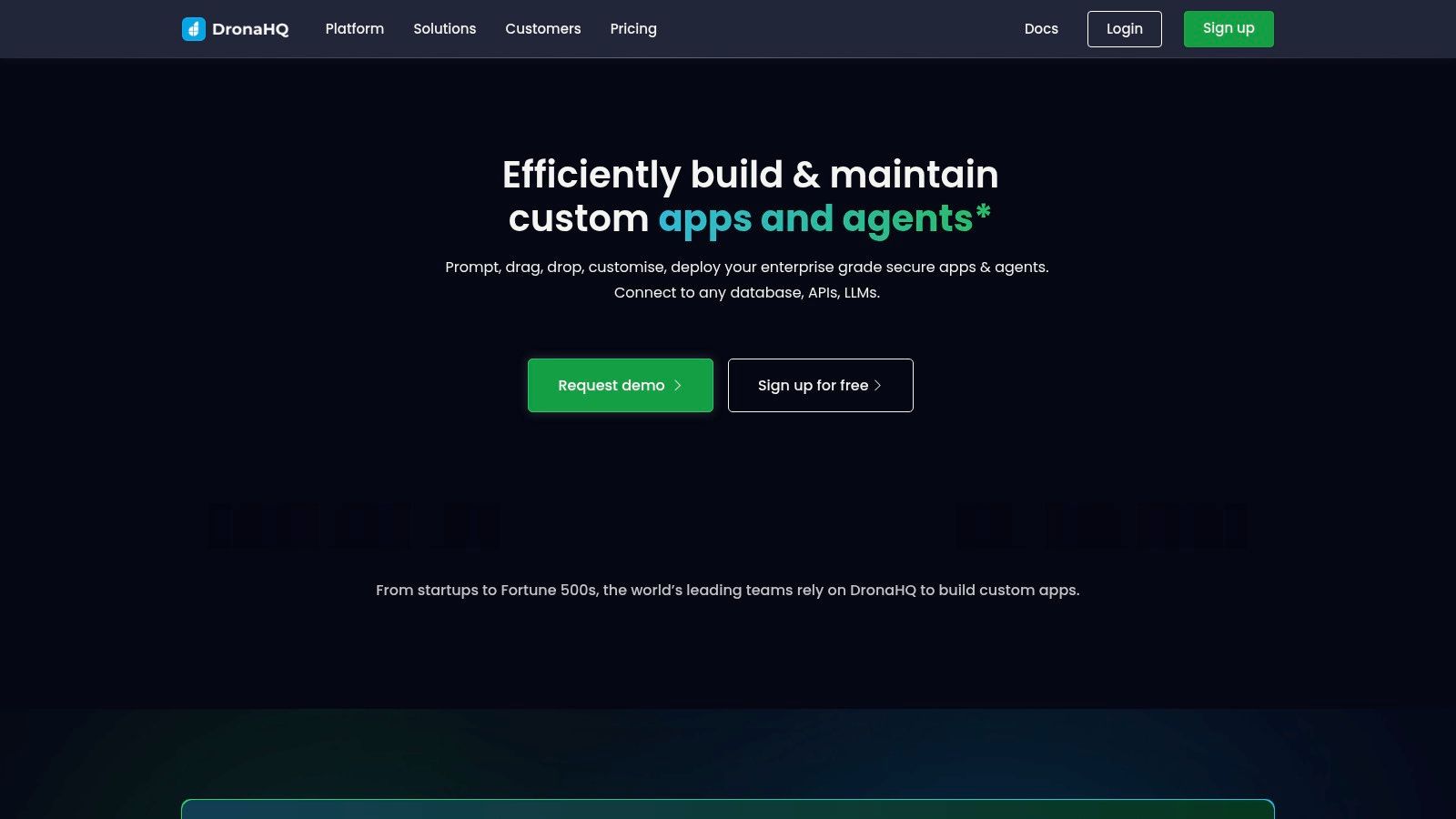
Its focus on internal tool creation makes DronaHQ one of the best low-code development platforms for teams looking to digitize and automate internal processes. The platform includes an online database and code editors, providing the flexibility to handle custom logic and connect to virtually any data source or third-party service via API. This balance of simplicity and extensibility allows teams to move from idea to functional internal app in a fraction of the traditional time.
Key Considerations
- Best Use Case: Building custom internal tools, admin panels, operational dashboards, and database GUIs to improve operational efficiency.
- Pricing: DronaHQ offers a free plan for up to 5 users. Paid plans are based on the number of users and features, with pricing starting at a competitive level for small to mid-sized teams.
- Limitations: While excellent for internal apps, it has limited support for highly complex, customer-facing applications with intricate business processes. Functionality can also be dependent on third-party integrations. For those seeking a more AI-driven approach to app creation, an AI app generator like Dreamspace could provide a faster, more automated development experience.
Website: https://www.dronahq.com
12. Quickbase
Quickbase specializes in empowering business users to create customized applications that streamline and automate unique internal processes. It excels at centralizing data from disparate sources, like spreadsheets and legacy systems, into a single, cohesive application environment. The platform is known for its user-friendly, database-centric approach, where users can build apps around their data models using an intuitive visual interface and drag-and-drop functionality.
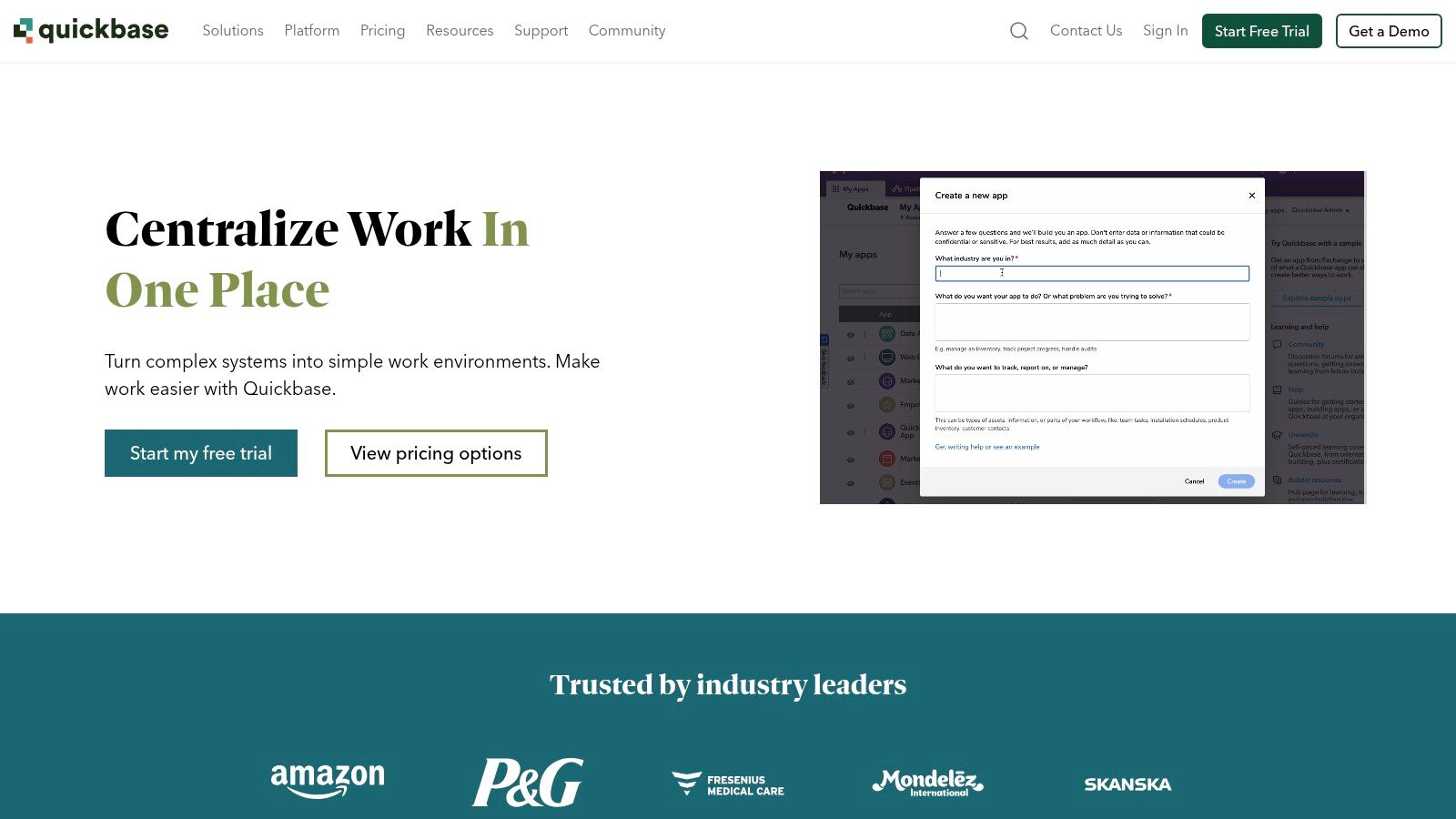
This focus on operational agility makes Quickbase one of the best low-code development platforms for non-technical teams looking to solve specific workflow challenges without extensive developer involvement. It allows organizations to rapidly build and deploy solutions for project management, CRM, and compliance tracking, connecting teams and unlocking insights from previously siloed information. Its built-in automation and integration capabilities further enhance operational efficiency.
Key Considerations
- Best Use Case: Creating custom internal tools and business process applications for departments like operations, project management, and sales to replace manual spreadsheet-based workflows.
- Pricing: Pricing is based on plans that include a set number of users and customizable apps. It can become expensive for large-scale deployments, so it's best suited for targeted departmental solutions.
- Limitations: While excellent for internal process apps, Quickbase has limited capabilities for creating complex, customer-facing applications or advanced UI customizations. For teams wanting to build a polished MVP with AI functionality from the ground up, an AI app generator like Dreamspace may provide a more direct path.
Website: https://www.quickbase.com
Making Your Final Decision: The Future is Low-Code
Navigating the landscape of the best low code development platforms can feel complex, but the journey to finding the right tool is a strategic investment in your organization's agility and innovation. As we've explored, the "best" platform isn't a universal title but a relative one, defined by your unique project requirements, existing technology ecosystem, and the specific problems you aim to solve.
The key takeaway is that selection must be purpose-driven. You wouldn't use a high-powered enterprise solution like OutSystems for a simple internal workflow, just as you wouldn't rely on a basic form-builder for a mission-critical, customer-facing application. Your choice hinges on a careful evaluation of your core needs.
A Quick Recap of Your Options
- For the Enterprise Powerhouse: Platforms like Mendix, OutSystems, and Appian excel in complex, large-scale enterprise environments. They offer robust governance, extensive integration capabilities, and the scalability required for mission-critical systems.
- For the Ecosystem-Integrated Team: If your business operations live within a specific suite, Microsoft Power Apps and Salesforce Lightning are the logical, deeply integrated choices. They leverage existing data and user management, accelerating development within their respective ecosystems.
- For the Web3 & AI Pioneer: For developers and vibe coders pushing the boundaries of what's possible, a platform like the Dreamspace vibe coding studio offers a unique advantage. It's specifically tailored for building onchain applications and AI-powered experiences, a niche that traditional platforms are not equipped to handle.
- For the SMB & Departmental Innovator: Tools like Zoho Creator, Kissflow, and Quickbase provide the perfect balance of power and simplicity for smaller teams or departments. They empower citizen developers to solve specific business problems quickly, from automating workflows to building custom internal tools, without requiring massive budgets or specialized coding skills.
Actionable Steps for Choosing Your Platform
To move from analysis to action, follow a structured evaluation process. Don't just rely on feature lists; get your hands on the tools.
- Define Your Core Use Case: What is the primary application you need to build? Is it an internal process automation tool, a customer portal, a mobile field app, or a decentralized application on the blockchain? Be specific.
- Assess Your Team's Skillset: Do you have professional developers who will use the platform to accelerate their work, or are you empowering business users with no coding background? Your choice of platform, from Betty Blocks to DronaHQ, must align with their capabilities.
- Request Personalized Demos and Trials: Engage with the vendors of your top 2-3 choices. A demo tailored to your use case is invaluable. Use free trials to build a small proof-of-concept (PoC) to test the platform's usability and limitations firsthand.
- Consider Total Cost of Ownership (TCO): Look beyond the initial license fee. Factor in costs for deployment, training, maintenance, and potential future scaling.
The low-code movement is fundamentally reshaping how we approach software development. By selecting one of the best low code development platforms that aligns with your strategic goals, you are not just adopting a new tool; you are embracing a new paradigm of speed, collaboration, and innovation. The future is built faster, and it's built with low-code.
Ready to build what's next in the world of AI and Web3? While traditional platforms handle business workflows, Dreamspace is the AI app generator and vibe coding studio designed for the new internet. Explore our platform to see how you can create and launch innovative onchain apps with unprecedented speed and creativity. Visit Dreamspace to begin your journey.